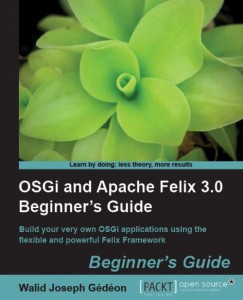| title | OSGi and Apache Felix 3.0 Beginner’s Guide |
| published | November 2010 |
| ISBN | 978-1-849511-38-4 |
| More info | www.packtpub.com |
At the end of 2010 I reviewed the book “OSGi and Apache Felix 3.0 Beginner’s Guide“. The people from packt publishing contacted me based on my involvement in the past with OSGi and felix. I wrote a number of blog posts on OSGi and felix and gave a presentation at the NLJug together with Allard about the topic. On this page I want to give a short summary of the book and tell you what I think about the book. You can buy the book from Packt Publishing through their website.
Summary of the book
The book takes you on a journey from an OSGi novice to an experienced Apache Felix user. It starts with a very basic explanation of what OSGi is and what an OSGi container provides. The next step is to setup your environment. You can follow along using the command line and maven, but you can also take the appendix and setup eclipse. I tried all the samples from within Intellij which worked fine as well. Just before print a nice chapter was added about Felix Gogo. The author did a good job describing what you can do with Gogo and why it is so nice to use for your container interaction. The book makes use of a sample application that is created throughout the book. So if you follow along you will have a complete Bookshelf project with all nice OSGi things in it. This makes the book very practical.
We have reached chapter 5, now the real coding starts of. You are creating and deploying real bundles. I like the approach of showing the actual outcome of some of the commands, you can really check if you did the right thing. Next up is talking about the bundle repositories, how to get to these nice libraries others have created so you can use them. Than more coding, use these libraries that you just found in available repositories.
You should be familiar with the basics right now, time to take the next step and make life easier. The iPojo project is introduced. No not something related to Apple, but it does make your life better :-). iPojo introduces inversion of control to your bundles. After iPojo the logging service is discussed very extensive. And believe me, you are going to need it. One of the final steps for the application is creating a graphical user interface. Using servlets in your container is explained.
One of the things new to me was the Web Management Console. After reading this chapter I was more motivated to start using Felix. A very nice addition to manage your felix container.
My thoughts
I think that OSGi and Apache Felix 3.0 is a very good book for beginners in the OSGi play field. It does an excellent job in taking the reader by the hand and making him try the sample code. The amount of code and theory is in good balance. I personally like it a lot that often you are provided with the output of certain commands. That way you can really check if you are on the right path.
I also like the layout of the book, nice fond (not to small) and clear images and code.
So should you buy the book? If you are not familiar with Apache Felix and you are abut to use it, yes you should buy it. Good value for money. If you are new to OSGi and want to learn more about it, yes you should buy the book. But make sure you read some of the provided links in the book to learn more about OSGi and then use the book to get practical.
If you have questions or comments, feel free to do so. If you want to buy the book and do not mind that I get some money out of it :-), please use one of the following links.
OSGi and Apache Felix 3.0 Beginner’s Guide – from amazon
OSGi and Apache Felix 3.0 Beginner’s Guide – from packtpub
